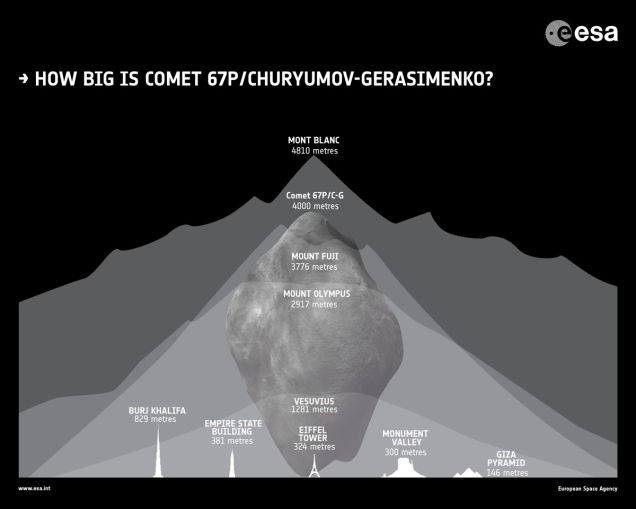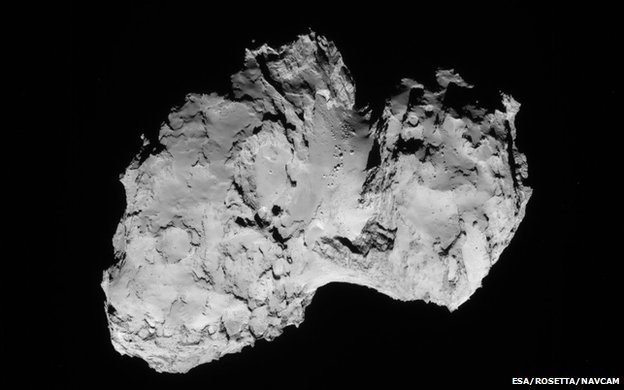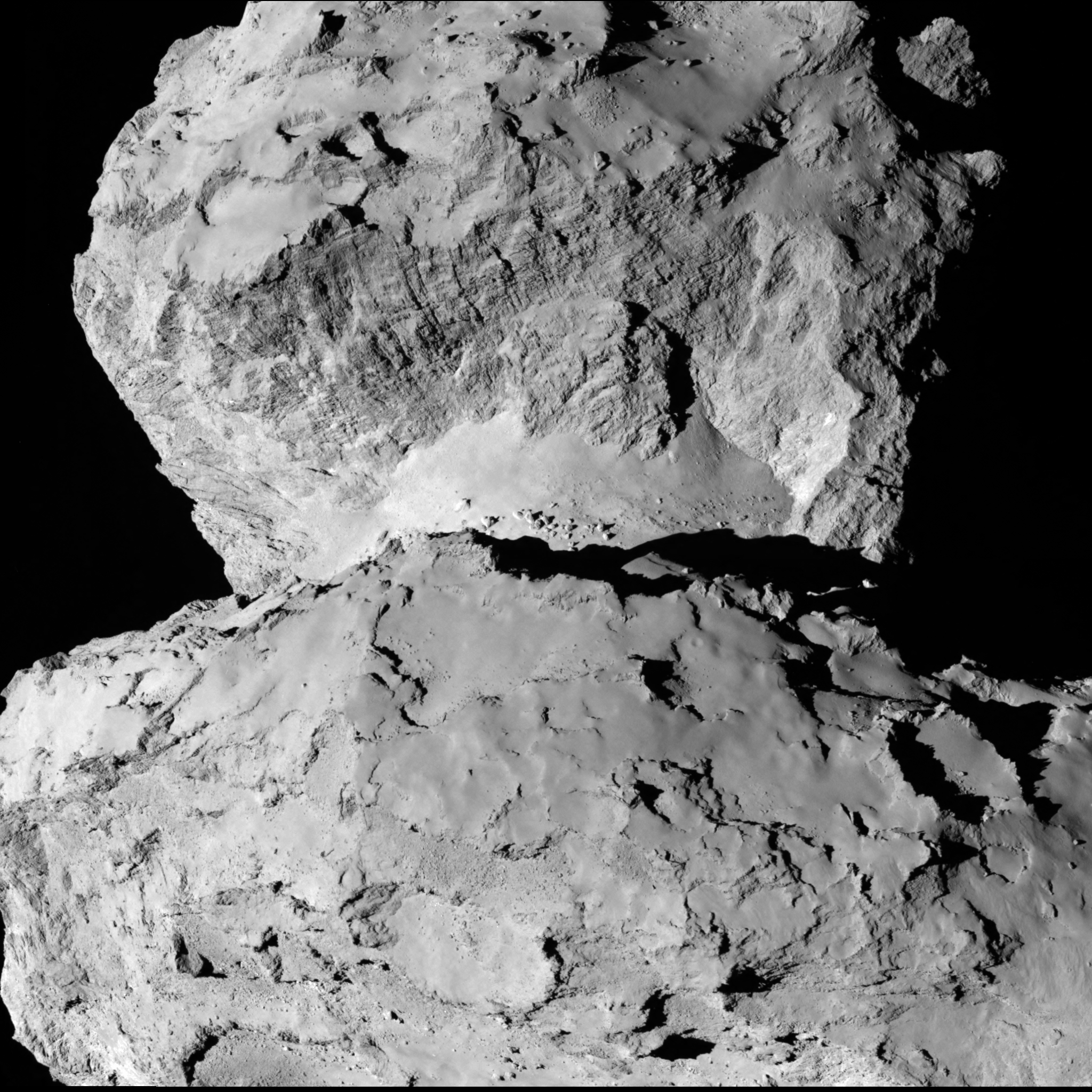It looks like you're using an Ad Blocker.
Please white-list or disable AboveTopSecret.com in your ad-blocking tool.
Thank you.
Some features of ATS will be disabled while you continue to use an ad-blocker.
share:
very interesting thread, thank you all, eagerly awaiting updates.....
Correct me if I'm wrong, but, shouldn't it be something like this?
comet density = 300 kg / m³
water density = 1000 kg / m³
air density = 1.225 kg / m³
comet density = 300 kg / m³
water density = 1000 kg / m³
air density = 1.225 kg / m³
originally posted by: OccamsRazor04
The very fact you can't accept the data shows how wrong you are.
It's not a question of accepting the data ... it's a question of not accepting the standard model.
0.3g/cm3 is even less than pumice, which is 0.6g/cm3. And given the fact, that it's ice that is being plummeted away when we see it in the sky, and the ice is 0.9g/cm3. It sounds more than just a little out in error land.
originally posted by: bjarneorn
300 kg/m3 is the same as 0.3g/cm3
But 1.225 kg / m³ is the same as 0.001225 g / cm³, right? If that's true then the comet is 244 times heavier than air, not lighter than air as you said, although I see that you changed your post and now it compares the comet's density with ice's density.
originally posted by: bjarneorn
originally posted by: OccamsRazor04
The very fact you can't accept the data shows how wrong you are.
It's not a question of accepting the data ... it's a question of not accepting the standard model.
0.3g/cm3 is even less than pumice, which is 0.6g/cm3. And given the fact, that it's ice that is being plummeted away when we see it in the sky, and the ice is 0.9g/cm3. It sounds more than just a little out in error land.
If it was supposed to be pure ice, you'd be right. That is not at all what they claim. What do you not get about porous? It has large empty spaces. When the data is CONFIRMED you will do what you people always do and jump ship to a new argument despite the fact right now you are saying it can't be right.
a reply to: TimeAfterTime
That's just a scale picture as if someone (I'm not saying Superman, but Superman) picked it up from outer space and gently sat it next to a city. Made me have a 'wowsers' moment, seeing it next to something we can judge size with makes it all the more real to me.
I'd say if something that big hit us, it would be a real nuisance especially if you've just put out the washing.
That's just a scale picture as if someone (I'm not saying Superman, but Superman) picked it up from outer space and gently sat it next to a city. Made me have a 'wowsers' moment, seeing it next to something we can judge size with makes it all the more real to me.
I'd say if something that big hit us, it would be a real nuisance especially if you've just put out the washing.
originally posted by: ArMaP
originally posted by: OccamsRazor04
EU proponents would have us believe that Rosetta is a big hunk of rock, just like an asteroid, no different.
Isn't Rosetta the probe and the comet 67P/Churyumov-Gerasimenko?
What pop-culture wants, pop-culture gets.
duh roseta stone, herp. ;-)
a reply to: Qumulys
Actually, you got the scale wrong.
67P/Churyumov is only 2.5 miles at it's widest.
That's the long length of Central Park in Manhattan. It would actually sit in the middle of Manhattan Island with room to spare.
The image you showed has a vista of many tens of miles wide, and the comet is not that big.
Actually, you got the scale wrong.
67P/Churyumov is only 2.5 miles at it's widest.
That's the long length of Central Park in Manhattan. It would actually sit in the middle of Manhattan Island with room to spare.
The image you showed has a vista of many tens of miles wide, and the comet is not that big.
originally posted by: bjarneorn
originally posted by: OccamsRazor04
The mass for this comet is EXACTLY as standard model would predict, and not at all what EU model predicts.
Really ... that sounds like a bit naive to me.
You have no idea, what the mass of this object is. It's an estimated "guess", based on size and projectory ... but to be able to calculate the mass, of any object. You need it's weight, and the acceleration. All of which, are estimates from observation ... and very very very far, from being accurate. Although, they're usually accurate enough.
Now, saying this object is 0.3g/cm3 does not sound quite right to me. If it was this light, I have a hard time seeing how it would even "stick together" ... after all, even ice is 0.9g/cm3. This object is lighter than ice.
Sorry bud, this does sound like whatever parameters were used to calculate this stuff ... is way out in error land.
So, I say ... stay tuned for updates.
And you're the expert on astrophysics? Can you show conclusively that their current estimates are wide off the mark?
"You have no idea, what the mass of this object is." - yes we do, based not only on the earlier observations, but also from the way the comet's mass affects the spacecraft gravitationally.
it is from the way the comet's close proximity bent the satellite's path that scientists could gauge a mass.
"Operationally, this can mean that planned orbits may be modified, as they assumed a different mass and hence gravity field," explains Taylor.
"Later, we will get more accurate information, in particular focusing on the centre of mass location, which will certainly come into play for landing site selection."
Science is about measuring, learning, and refining the results. That's what's happening here.
The comet has enough mass to make its escape velocity in the range of 0.7 m per second, which means that unless you push stuff outwards at that speed, it's gonna slowly fall towards the centre of the mass, and stay there.
Sorry, but if it sounds naive to you, and you have no idea how such a low-density object could stick together through gravity, then you simply don't have enough knowledge about science and physics involved here.
The Rosetta team have done their homework. Have you?
edit on 23-8-2014 by wildespace because: (no reason given)
originally posted by: ArchPlayer
a reply to: Qumulys
So is Rosetta the infamous Wormwood then?
ssshhh! don't even go there...
edit on R2014rd2014-08-23T10:28:14-05:0020140am2344 by RoScoLaz4 because: i messed up
a reply to: eriktheawful
Ahhh. Well, I blame this link
(Not sure if it will stay translated in english, but they said:
Apparently thats just part of LA... But who knows, I didn't make the image myself. But this pic might best portray it's scale. (Mind you, it's still a Gizmodo source, so who knows...)

Ahhh. Well, I blame this link
(Not sure if it will stay translated in english, but they said:
We have seen many pictures of the comet 67P / Churyumov- Gesasimenko to the Rosetta probe has made it after 10 years of travel. However, one of the best images to understand its actual size is the illustration above, compared with the city of Los Angeles.
Apparently thats just part of LA... But who knows, I didn't make the image myself. But this pic might best portray it's scale. (Mind you, it's still a Gizmodo source, so who knows...)

The new mass determination for comet 67P/ Churyumov-Gerasimenko is probably reasonably accurate. The comet's size, and so its volume are known, in a
general way, although the European Space Agency has declined to issue a density calculation until the size and shape are better defined.
The mass estimate is about three times the old one. One scientific source had given a density estimate of 100 kilograms per cubic meter, based on the old assumed mass. The density figure of 300 kilograms is a reasonable provisional inference, based on the new data.
Most comets with well defined densities run about 600 kilograms per cubic meter, or twice that supposed for comet 67P. One exception is comet Borelly, which has an apparent density similar to that inferred for 67P.
A comet with such a density can hold itself together, it seems.
There is one remaining problem, though. Comet Borelly is unmarked by any substantial craters. Either it's managed to avoid any large impacts, or has been torn apart by such impacts, and slowly reassembled itself via mutual gravitation of the fragments. Such a reassembly would probably have erased any traces of craters.
We see a number of apparent impact craters on comet 67P. The largest of these appears on the smaller of the two lobes of the object. It seems to be about half the diameter of this lobe. Given this comet's probably low density, one wonders how this lobe of the comet escaped being shattered by the impact.
Subject to the confirmation that the large circular feature is an impact crater, this extraordinary resilience or resistance to disruption will have to be explained.
The mass estimate is about three times the old one. One scientific source had given a density estimate of 100 kilograms per cubic meter, based on the old assumed mass. The density figure of 300 kilograms is a reasonable provisional inference, based on the new data.
Most comets with well defined densities run about 600 kilograms per cubic meter, or twice that supposed for comet 67P. One exception is comet Borelly, which has an apparent density similar to that inferred for 67P.
A comet with such a density can hold itself together, it seems.
There is one remaining problem, though. Comet Borelly is unmarked by any substantial craters. Either it's managed to avoid any large impacts, or has been torn apart by such impacts, and slowly reassembled itself via mutual gravitation of the fragments. Such a reassembly would probably have erased any traces of craters.
We see a number of apparent impact craters on comet 67P. The largest of these appears on the smaller of the two lobes of the object. It seems to be about half the diameter of this lobe. Given this comet's probably low density, one wonders how this lobe of the comet escaped being shattered by the impact.
Subject to the confirmation that the large circular feature is an impact crater, this extraordinary resilience or resistance to disruption will have to be explained.
edit on 23-8-2014 by Ross 54 because: improved paragraph structure.
A thread declaring the (near) death of a theory and no pictures of the 'corpus delicti'?
 blogs.esa.int...
blogs.esa.int...

Just out of respect - some documented statements from the soon to be deceased. thunderbolts.info...


Just out of respect - some documented statements from the soon to be deceased. thunderbolts.info...
What an odd title for a thread. Thunderbolts and electric universe theorists are following this and not really surprised at the findings.
www.thunderbolts.info...
Rosetta Mission Findings: No Room for Dirty Snowballs | Space News
Different interpretations?
The most important articles will be up close, which is still ahead. And NASA has already studied comets up close and they didn't fit their models, they fit the electric universe models.
So if you studied 4 comets up close, and lets just pretend that this one is abnormal to the other 3, and 1 is different, would that change the average results?
Or in your mind, the one anomalous one would blow the other ones out of the water?
You're title is very speculative and in error.
www.thunderbolts.info...
Rosetta Mission Findings: No Room for Dirty Snowballs | Space News
Different interpretations?
The most important articles will be up close, which is still ahead. And NASA has already studied comets up close and they didn't fit their models, they fit the electric universe models.
So if you studied 4 comets up close, and lets just pretend that this one is abnormal to the other 3, and 1 is different, would that change the average results?
Or in your mind, the one anomalous one would blow the other ones out of the water?
You're title is very speculative and in error.
new topics
-
President BIDEN's FBI Raided Donald Trump's Florida Home for OBAMA-NORTH KOREA Documents.
Political Conspiracies: 2 hours ago -
Maestro Benedetto
Literature: 4 hours ago -
Is AI Better Than the Hollywood Elite?
Movies: 4 hours ago -
Las Vegas UFO Spotting Teen Traumatized by Demon Creature in Backyard
Aliens and UFOs: 7 hours ago -
2024 Pigeon Forge Rod Run - On the Strip (Video made for you)
Automotive Discussion: 8 hours ago -
Gaza Terrorists Attack US Humanitarian Pier During Construction
Middle East Issues: 9 hours ago -
The functionality of boldening and italics is clunky and no post char limit warning?
ATS Freshman's Forum: 10 hours ago -
Meadows, Giuliani Among 11 Indicted in Arizona in Latest 2020 Election Subversion Case
Mainstream News: 10 hours ago -
Massachusetts Drag Queen Leads Young Kids in Free Palestine Chant
Social Issues and Civil Unrest: 11 hours ago
top topics
-
President BIDEN's FBI Raided Donald Trump's Florida Home for OBAMA-NORTH KOREA Documents.
Political Conspiracies: 2 hours ago, 23 flags -
Krystalnacht on today's most elite Universities?
Social Issues and Civil Unrest: 14 hours ago, 9 flags -
University of Texas Instantly Shuts Down Anti Israel Protests
Education and Media: 16 hours ago, 8 flags -
Weinstein's conviction overturned
Mainstream News: 12 hours ago, 8 flags -
Supreme Court Oral Arguments 4.25.2024 - Are PRESIDENTS IMMUNE From Later Being Prosecuted.
Above Politics: 13 hours ago, 8 flags -
Massachusetts Drag Queen Leads Young Kids in Free Palestine Chant
Social Issues and Civil Unrest: 11 hours ago, 7 flags -
Gaza Terrorists Attack US Humanitarian Pier During Construction
Middle East Issues: 9 hours ago, 7 flags -
Las Vegas UFO Spotting Teen Traumatized by Demon Creature in Backyard
Aliens and UFOs: 7 hours ago, 6 flags -
Meadows, Giuliani Among 11 Indicted in Arizona in Latest 2020 Election Subversion Case
Mainstream News: 10 hours ago, 5 flags -
2024 Pigeon Forge Rod Run - On the Strip (Video made for you)
Automotive Discussion: 8 hours ago, 4 flags
active topics
-
-@TH3WH17ERABB17- -Q- ---TIME TO SHOW THE WORLD--- -Part- --44--
Dissecting Disinformation • 687 • : Justoneman -
Reason of the Existence
The Gray Area • 21 • : BingoMcGoof -
President BIDEN's FBI Raided Donald Trump's Florida Home for OBAMA-NORTH KOREA Documents.
Political Conspiracies • 10 • : nugget1 -
Supreme Court Oral Arguments 4.25.2024 - Are PRESIDENTS IMMUNE From Later Being Prosecuted.
Above Politics • 85 • : Sookiechacha -
Chris Christie Wishes Death Upon Trump and Ramaswamy
Politicians & People • 24 • : nugget1 -
New whistleblower Jason Sands speaks on Twitter Spaces last night.
Aliens and UFOs • 63 • : pianopraze -
SETI chief says US has no evidence for alien technology. 'And we never have'
Aliens and UFOs • 74 • : Justoneman -
Starburst galaxy M82 - Webb Vs Hubble
Space Exploration • 6 • : Arbitrageur -
University of Texas Instantly Shuts Down Anti Israel Protests
Education and Media • 264 • : stelth2 -
VirginOfGrand says hello
Introductions • 9 • : TheMichiganSwampBuck
